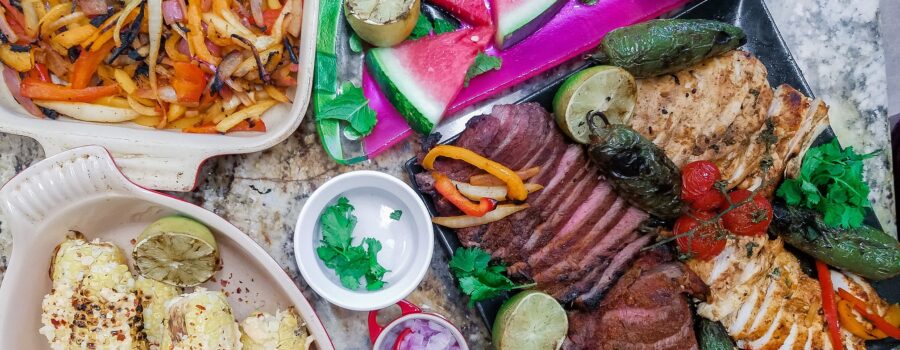In various conversations we’ve had or seen, people sometimes say they have a hard time eating the healthy food they’d like because it doesn’t fit in their budget. While this challenge is understandable, we want to share a few things to consider related to this mindset:
Organic food prices have decreased in many stores (for produce, especially) and oftentimes are not significantly more expensive than buying conventional versions.
Some stores’ food items are more expensive than others, including even conventional products. We’ve heard so many comments over the years about Whole Foods being expensive. And yet, each time we attempt to purchase the same or similar products from Hy-Vee, a popular grocery store chain in the Midwest, the items are and always have been as expensive or more than when we shop at Whole Foods. In fact, their conventionally-grown produce is oftentimes the same price as the organic produce we buy at Whole Foods!
If you are someone who buys a lot of prepared or packaged foods, it’s very likely that making your own meals will be more economical (and better for you), and that even factors in using organic ingredients!
Consider what’s important to you. We’re talking about food. The stuff that nourishes your body and fuels your mind and makes a direct impact on your everyday happiness and your long-term health and longevity. When it comes to budgeting, we personally choose to spend more on groceries to supply ourselves with amazing and delicious food, and less on going out to eat at restaurants, material items or entertainment.
This may sound harsh, but you can either pay for your health now or pay for it later. By purchasing the highest quality food you can afford (and we believe most people can afford more than they think when they look at other places they are spending that don’t support their health), you are supporting prevention of chronic disease and ailments. When you eat a diet high in processed foods, seed oils, sugars and flour, you are causing inflammation in your body and promoting insulin resistance and weight gain. Many people living with chronic disease today find themselves paying for medical expenses to manage their symptoms AND don’t physically or mentally feel their best either. We would raise an eyebrow to the budget that doesn’t have room for healthy groceries, but includes any combination of regular coffee shop stops, frequent nail salon visits, multiple subscription box services, the latest device or a bigger or better TV, a higher end car or home, or visiting a restaurant more than once per week. Are those activities or things more important than your health? It’s an important question to ask yourself. No one says you need to cut out all “feel good” items in your life, but likely there are a couple places you could trim if healthy food was important enough to you.
With these ideas in mind, let’s explore four ways to eat healthier food while on a budget:
- Reduce how often you eat at restaurants
- Determine your organic must-haves and nice-to-haves
- Figure out which local stores have the best prices
- Buy less popular cuts or types of meat
- Invest in some meal prep tools to reduce food costs
1. Reduce how often you eat at restaurants.
Restaurants provide a service – which is to prepare food for you to eat. As a result, the price you’ll pay for your meal at a restaurant is more than it would cost you to make at home. Plus, nearly every restaurant uses seed oils to cook their food, which are extremely bad for our health. Not only will your bank account benefit by you eating out less, your body and mind will, too. If you want to eat better AND save money, cook and prep more meals from home and save eating out at restaurants for a special occasion every once in a while.
If you don’t consider yourself a good cook, know that with practice, you will become more skilled and amazed by your abilities! Plus, if you follow our content, start trying the recipes on this site and using the ingredients we share and talk about here and on social media instead of whatever you’re used to. We can almost guarantee you will start loving your own cooking more than eating out. A bold assumption, we know, yet we stand behind it!
2. Determine your organic must-haves and nice-to-haves.
If your budget does not allow you to buy all organic foods, decide what items you are comfortable buying non-organic. You might consider these “dirty dozen” and “clean fifteen” lists for helping you decide. The dirty list includes the top 12 produce items you should strive to buy organic whenever possible (like strawberries), because of their high exposure to pesticides and chemicals when grown conventionally. The clean list includes the top produce items that when grown conventionally, contain the least amount of pesticides or chemicals.
Produce that doesn’t make these lists falls somewhere in between and you can either search online for information about conventional growing practices, or just decide what you’re comfortable with. As a personal example, avocados are a food that we buy weekly and they are one of the “clean fifteen” foods. As a result, sometimes we buy the bag of six conventionally grown avocados from Costco for $7.99, or $1.33 each. When organic avocados are on sale from Whole Foods for $1.50, then we might buy those instead.
3. Figure out which local stores have the best prices – then shop there.
You may benefit by learning about other grocery stores or suppliers in your geography. As I shared at the start of this article, the stores you currently frequent may be more expensive than others in your town or city. Many people we talk to are surprised to learn that most produce and meats at Whole Foods are cheaper than the popular Midwest grocery chain that they shop at (and markets their “great” prices).
To illustrate this idea of “strategic shopping,” I’ll share my personal approach. I shop primarily at Whole Foods and Costco, plus a few local producers and growers.
At Costco, we often buy the following:
- Organic Broccoli florets, 3-lb bag, $7.99 – even once opened, a bag can last a couple weeks if stored properly
- Organic Brussels sprouts, $6.99 – like broccoli, a bag can last more than a week once opened if stored properly
- Organic mushrooms, 24oz, $5.99 – I like to chop these up and freeze part of them for later use
- Organic English cucumbers, 3-pack, around $5
- Organic Carrots – I can’t remember how much this is because we don’t eat carrots very much. But it’s a great deal for someone who does! It’s a huge bag and could easily be used up in a few weeks with a little planning
- Kerrygold Butter, four 8oz sticks for $11.99 – this is the cheapest you can find Kerrygold butter anywhere! Most stores sell a single stick for $4-$5! Kerrygold butter is made from pasture-raised cows, which is evident by its noticeably yellow color. It’s also the best tasting butter we’ve ever had. Butter is one of the best healthy fats you can eat and cook with.
- Organic eggs, 2-dozen package, $5.99 ($3 a dozen) – Costco eggs are certified humane, which means the birds live a higher quality of life, and as a result, their eggs may potentially have a better nutritional profile as well! We buy most our eggs from a local farmer (I’ll share more below), but when we’re in a pinch and need them right away, I buy from Costco
- Wild-caught sardines, 6-pack, $9.99 ($1.66 a tin) – I also buy Wild Planet sardines from Amazon at around $1.20 a tin
- Sauerkraut, 50oz, around $7 – this is far cheaper than I can find elsewhere
- Frozen wild Alaskan salmon filets, 3lbs, $33 ($4 per piece)
- Other items at great prices that we sometimes buy – certain cheeses, frozen organic berries and red wine
We skip the large packages of cookies, candies, chips, frozen pizzas and prepared foods that you usually hear about from Costco. Our shopping carts typically look far different than other Costco shoppers’ carts!
At Whole Foods, we often buy the following:
- 80/20 Pasture-raised ground beef – $5.99 (although we rarely pay the full price – more on that below!)
- Wild-caught seafood and pasture-raised meats
- Various produce items that I don’t need in bulk, are on sale or aren’t sold at Costco
- Other fermented veggies
- Vital Farms eggs
Even Walmart has a small organic produce section if I’m ever in a pinch and can’t make it to my normal stores. They also carry the medium-sized Vital Farms eggs for only $3.99 a dozen!
As I mentioned, I also buy from some local farmers and ranchers or suppliers. Their products aren’t necessarily cheaper than what we can find in the store (although some are!), but their quality is often better AND we try to support our local farmers and producers when we can.
If you are in another geography and are curious about the local ranchers, farmers or producers in your area, visit this post and check out the second set of bullets for ideas!
4. Buy less popular cuts or types of meat.
I mentioned above that we buy 80/20 beef instead of lean 90/10 beef. The idea that saturated fat is bad for our health has been debunked. Our ancestors did not discard the fat from the animals they ate. Meat contained its normal fat content and any “leftover” fat was used as lard in other cooking. The 80/20 beef we buy from Whole Foods is $5.99, while the 90/10 beef is $7.99. Plus, not only is this fattier version cheaper, it TASTES better, too! It’ll help you make the most delicious and flavorful burgers, meatballs, taco meat and anything else. Fat also plays an important role in helping your body absorb nutrients and minerals in your food.
You can also save money by purchasing less popular cuts of meat. Most people buy lean muscle cuts, like chicken breasts and pork chops. You might be surprised to learn that lean muscle meats have the least amount of nutrition! Meat on the bone, dark meat and fattier meat all have greater nutritional profiles than lean meats. And, they’re cheaper. Next time you’re at the store, look at the difference between the cost of boneless skinless chicken breasts and boneless skinless thighs and see for yourself.
You will also get more bang for your buck by purchasing a pork shoulder roast or chuck roast and slow cooking it (or pressure cooking in an Instant Pot) until amazingly tender.
5. Take advantage of sales.
With a little sleuthing, you can find great savings by planning your meals based on the sales happening at your preferred stores.
I check the sales at my local Whole Foods using the Whole Foods and Amazon apps a few days before I plan to buy groceries. Then, I come up with my meal plan for the following week based on those sales.
We are Amazon Prime members, which means we get an additional 10% off any sale items at Whole Foods. That grass-fed 80/20 beef I referred to earlier is only $3.50/lb when it’s on sale! I stock up during sales and store the beef in the freezer, which means I rarely pay full price for beef. Other great sales that I watch for are:
- Pasture-raised chuck roast (around $4/lb on sale)
- Pasture-raised sugar-free bacon (around $5 on sale)
- Wild-caught king salmon (around $24/lb)
- Wild-caught Alaskan Halibut (around $19/lb)
- Wild-caught Calabrian chili salmon burgers ($8 for two patties)
- Good Culture Double Cream Cottage Cheese ($4 per container)
Invest in some meal prep tools to reduce food costs.
Some people buy pre-cut produce to save time from having to chop and prep. While this may save time, it costs more to buy these pre-cut or partially prepared items. Similarly, others purchase takeout or eat at restaurants because they don’t have time to cook at home, but it’s much more expensive to eat out (and the ingredients are always lower quality than what you could purchase/make for yourself).
Check out our article sharing our favorite meal prep tools here. While there is the initial investment cost (although some items are $25 or less!), they should last you a long time and allow you to purchase foods in their whole form. In addition, suggestions like the InstantPot make it easy to buy a large, tough cut of meat and turn it into something delicious (like the chuck roast I referred to) without a lot of hands-on time by you.
I hope these ideas offer some helpful ways for making healthy food the main focus of your grocery bill.
It is entirely possible to eat healthy and organic food on a budget. It merely takes a bit of planning and thinking about what strategy will work best for you!
And, if you have any additional thoughts or ideas that work for you, we’d love to hear from you!
Warm regards,
Brianna







